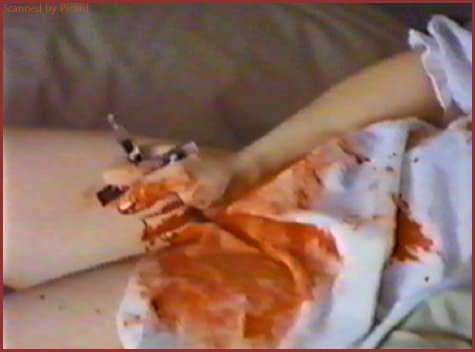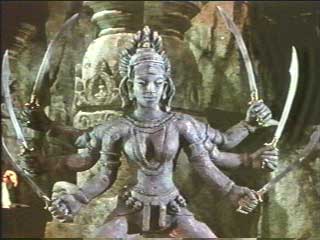Yo Quiero Exorcismo!

Lunes: Ahh...la nina bonita! Hola, nina! Hola! Nina? Hola?
Exorcisms Rise in Mexico, Keeping Father Mendoza, Healers Busy
from Bloomberg
Father Pedro Mendoza Pantoja, the Roman Catholic Church's highest-ranking exorcist in Mexico City, has never been busier.
Mendoza, 70, takes 15 phone calls a day from people who say they are possessed by the devil and sees about five of them for in-office consultations. They're part of the increasing number of Mexicans demanding exorcisms.
"Growing up, I don't remember a single person possessed by a demon," Mendoza said from his parish in Cuajimalpa, a town on the outskirts of Mexico City. "Every time a girl gets sick or acts strange, they send her over."

Nartes: 'La meme!'
Mexico is part of a global surge in exorcisms sparked by the Vatican's decision in 1999 to issue a new manual for the process, said Scott Lilienfeld, a professor of psychology at Emory University in Atlanta. Ninety-two percent of Mexico's 106 million people are Catholic.
The instructions on carrying out exorcisms are contained in the 84-page Roman Ritual, a book produced by the Vatican to outline how prayers and ceremonies should be handled. The revision to the section on exorcisms, the first since 1614, was made to reduce injuries and deaths, Lilienfeld said.
"I have to wonder if inadvertently they may have made it more popular by giving it a veneer of legitimacy," Lilienfeld said in a telephone interview. "The Vatican guidelines urge it be done with a medical professional. It may make it look like this is a real medical practice, which it is not."

Miercoles: 'La puerca es mia!'
A year after the Vatican published its new guidelines, the movie The Exorcist was re-released in theaters in the U.S. Mendoza said the movie, the second-highest-grossing U.S. horror film behind Jaws, also spurred demand for exorcisms. The film was originally released in 1973.
In Mexico, belief in possession and exorcism predates the arrival of the Spanish in 1519. Aztec healers burned herbs and prayed to ward off spirits. After the Spanish conquest, indigenous beliefs merged with Catholicism and the worship of saints.
According to a woman called Rosey, who describes herself as a healer and goes by only one name, people who believe they are possessed also seek out treatment in places such as Mexico City's Sonora Market. The market is a gathering place for such healers, who also sell herbs and candles used in saint worship.

Jueves: 'Que dia tan bello para un exorcismo.'
Rosey attributes the demand for demonic expulsions to the rise of infidelity and the breakdown in the Mexican family.
"I've had people come in and ask how much I will charge to kill their husbands," she said in an interview in the market.
Rosey said she knows a person is possessed when she touches them and a cold feeling passes through her body that hurts her bones. That's when she performs a "breaking." Rosey charges anywhere from $9 for a cleansing to 7,000 pesos for a full exorcism, which involves the burning of herbs and wood and evoking saints such as Elegua, known as the guardian of the crossroads. The Catholic Church doesn't charge for exorcisms.
Healers such as Rosey are part of the problem, Father Mendoza said. Many people who are suffering from a mental illness or drug addiction turn to healers, "where they then really do pick up a demonic influence or possession."

Viernes: 'El poder de Christo la obliga! El poder de Christo la obliga! El poder de Christo la obliga!'
Mendoza said he looks for the tell-tale signs of possession described by the Vatican guidelines, such as speaking in a foreign language the person has "no reason to know" or being "familiar with events in far away places or in other times.''
Some of those who aren't fully possessed by the devil suffer from "diabolic oppression," a lesser form of demonic invasion, Mendoza said. For those people, some Catholic churches in Mexico do mass ceremonies - called prayers of liberation - where hundreds are exorcised at the same time.
"Many exorcisms cure the oppressed and not the possessed," Mendoza said after he spent his whole day attending to people who said they were possessed. "True demonic possessions result from making a pact with the devil, from inviting the devil inside, sometimes without realizing it."

Sabado: 'Deje que Jesus la coja! Deje que Jesus la coja!'
In an exorcism, a priest performs a ceremony that includes sprinkling holy water onto the possessed person and reciting prayers ordering the devil to depart.
In August 2004, Father Mendoza coordinated Mexico's first national meeting of exorcists and "auxiliaries of liberation." The auxiliaries are those who aren't trained exorcists themselves. They aid the priest or bishop in his work. Mendoza declined to say how many exorcisms he performs.
The Vatican guidelines require a trained professional, such as a psychologist, to examine anyone before an exorcism, Lilienfeld said. The professionals determine whether someone is suffering from a mental illness such as schizophrenia or from epilepsy, conditions that priests commonly mistake for demonic possession.
"Sometimes exorcisms can go wrong, and a few people have been harmed or even killed by exorcisms when they have been accidentally strangled or beaten," he said. "It's dangerous, because a belief in exorcism can encourage the misdiagnosis of genuine psychiatric problems and encourage people to think of their problems as the result of indwelling entities."

Domingo: 'Su madre chupa verga en el Infierno, Karras, pinche basura sin fe!'




























1 Comments:
would anyone please tell me how I can find Father Pedro Mendoza. I'd like to interview him for our documentary project. Thanks in advance.
Dean
Post a Comment
<< Home